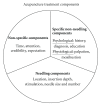Paradoxes in acupuncture research: strategies for moving forward
- PMID: 20976074
- PMCID: PMC2957136
- DOI: 10.1155/2011/180805
Paradoxes in acupuncture research: strategies for moving forward
Abstract
In November 2007, the Society for Acupuncture Research (SAR) held an international symposium to mark the 10th anniversary of the 1997 NIH Consensus Development Conference on Acupuncture. The symposium presentations revealed the considerable maturation of the field of acupuncture research, yet two provocative paradoxes emerged. First, a number of well-designed clinical trials have reported that true acupuncture is superior to usual care, but does not significantly outperform sham acupuncture, findings apparently at odds with traditional theories regarding acupuncture point specificity. Second, although many studies using animal and human experimental models have reported physiological effects that vary as a function of needling parameters (e.g., mode of stimulation) the extent to which these parameters influence therapeutic outcomes in clinical trials is unclear. This White Paper, collaboratively written by the SAR Board of Directors, identifies gaps in knowledge underlying the paradoxes and proposes strategies for their resolution through translational research. We recommend that acupuncture treatments should be studied (1) "top down" as multi-component "whole-system" interventions and (2) "bottom up" as mechanistic studies that focus on understanding how individual treatment components interact and translate into clinical and physiological outcomes. Such a strategy, incorporating considerations of efficacy, effectiveness and qualitative measures, will strengthen the evidence base for such complex interventions as acupuncture.
Figures




References
-
- NIH. NIH Consensus Conference. Acupuncture. Journal of the American Medical Association. 1998;280(17):1518–1524. - PubMed
-
- MacPherson H, Nahin R, Paterson C, Cassidy CM, Lewith GT, Hammerschlag R. Developments in acupuncture research: big-picture perspectives from the leading edge. Journal of Alternative and Complementary Medicine. 2008;14(7):883–887. - PubMed
-
- White AR, Filshie J, Cummings TM. Clinical trials of acupuncture: consensus recommendations for optimal treatment, sham controls and blinding. Complementary Therapies in Medicine. 2001;9(4):237–245. - PubMed
Grants and funding
LinkOut - more resources
Full Text Sources
Miscellaneous

